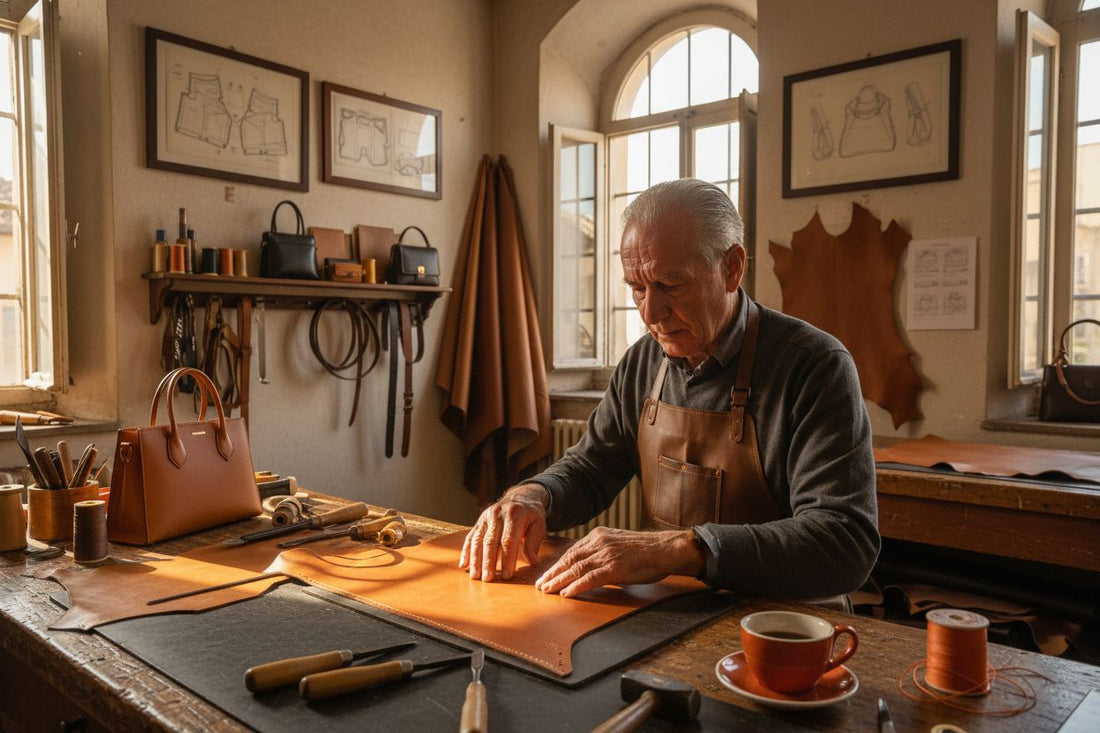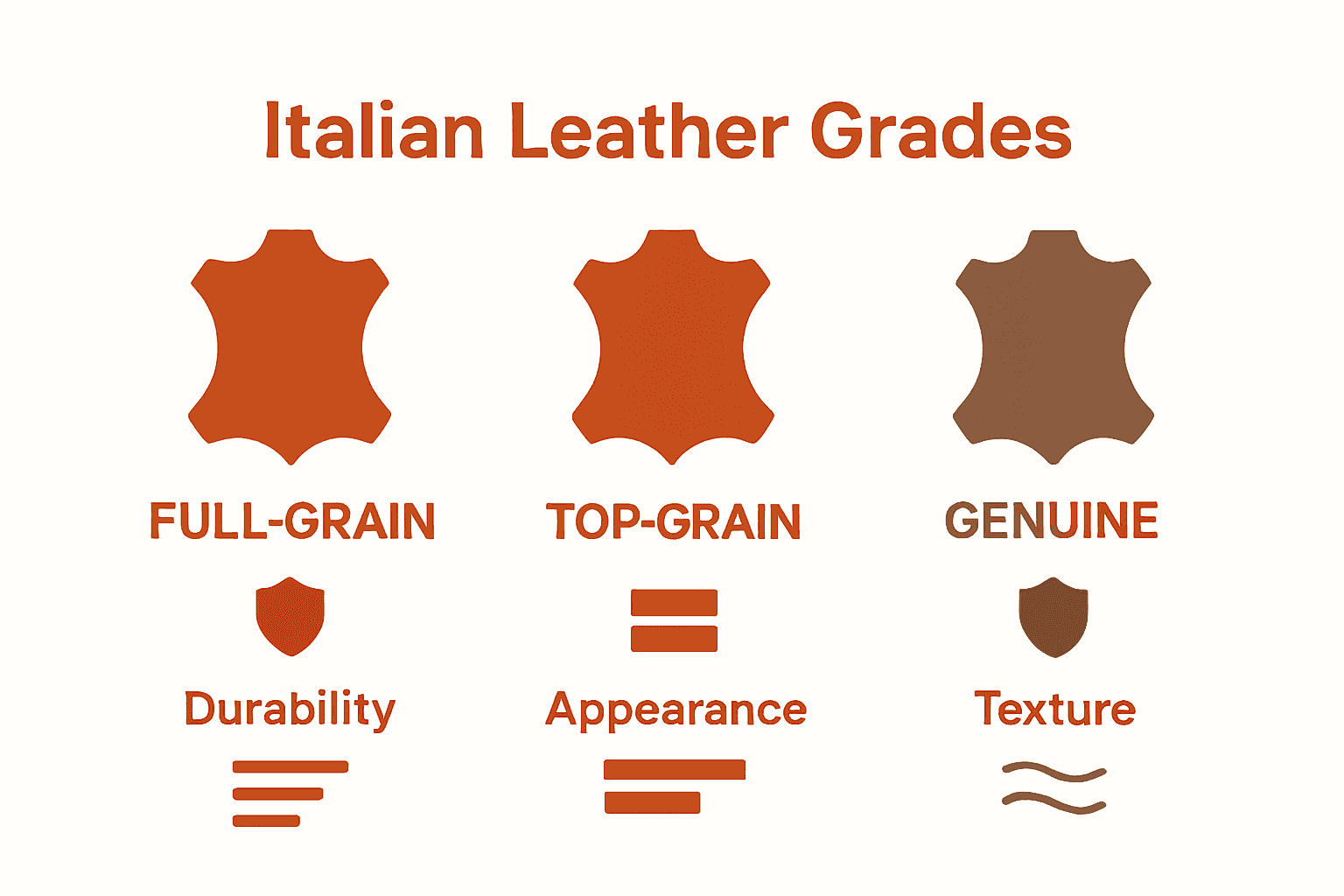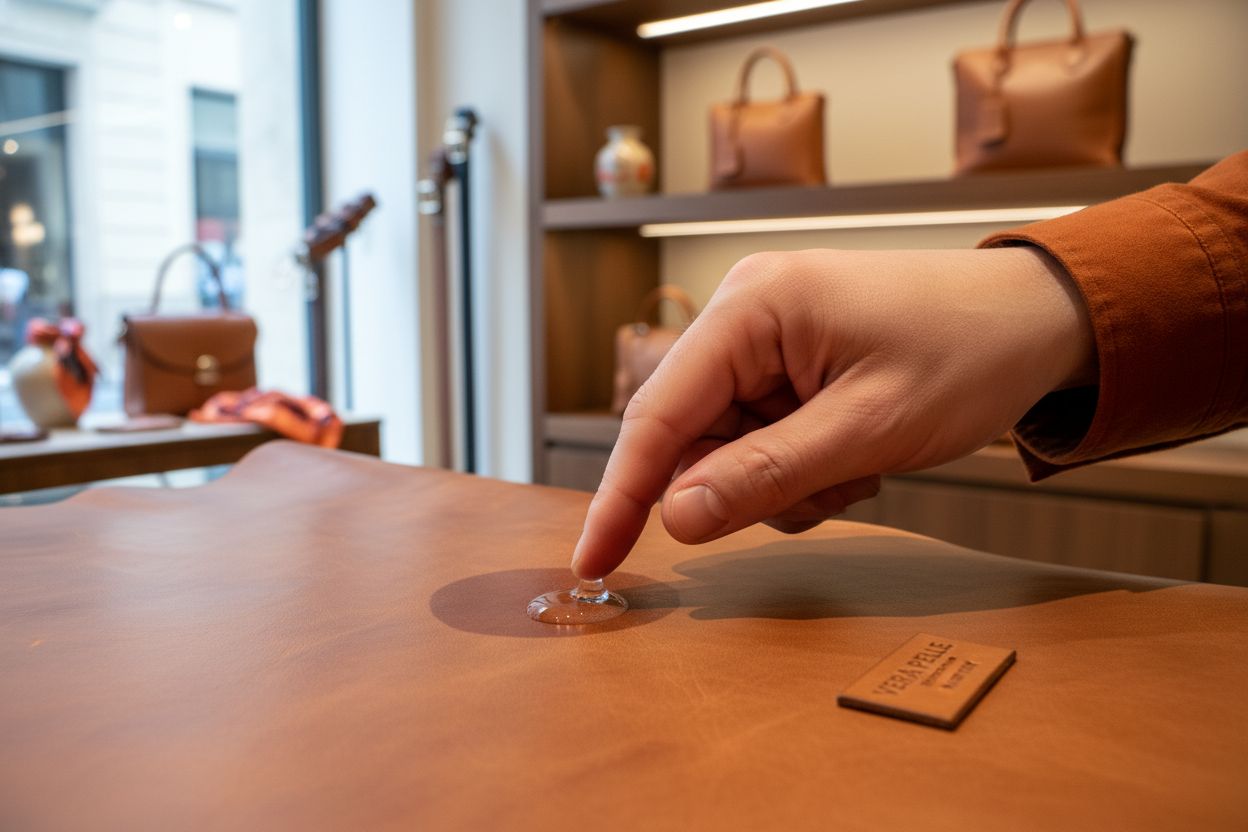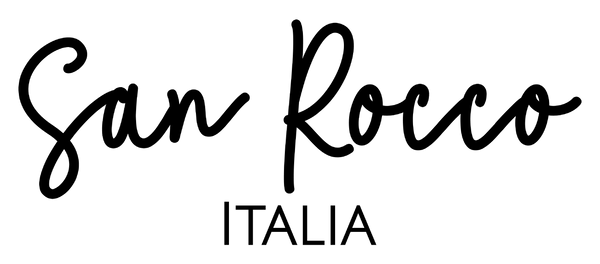
Complete Guide to Spotting Genuine Italian Leather
Share
Over 900 years of tradition shape some of the world’s most coveted leathers, with Italy setting the gold standard in quality and craftsmanship. Authentic Italian leather is trusted for its unmatched softness, rich aroma, and resilience that only improves with age. For those seeking true luxury, distinguishing genuine from imitation is essential. Small details reveal the artistry and heritage behind every real Italian leather piece, turning an ordinary purchase into a lifelong statement.
Key Takeaways
| Point | Details |
|---|---|
| Authenticity Standards | Genuine Italian leather must comply with strict Italian legal standards, ensuring that it is entirely conceived, manufactured, and packaged in Italy. |
| Leather Grades | The three primary grades of Italian leather—full-grain, top-grain, and genuine—vary significantly in quality and characteristics, with full-grain being the most prestigious. |
| Distinctive Characteristics | Authentic Italian leather features unique qualities such as a natural aroma, subtle grain variations, and craftsmanship details that distinguish it from counterfeit products. |
| Avoiding Counterfeits | Watch for red flags such as texture inconsistency, artificial appearance, and suspiciously low pricing to identify genuine Italian leather and avoid fakes. |
Table of Contents
- What Defines Genuine Italian Leather
- Types Of Italian Leather And Their Differences
- Key Characteristics Of Authentic Italian Leather
- Traditional Craftsmanship And Markings To Look For
- Common Pitfalls And How To Avoid Fakes
What Defines Genuine Italian Leather
Authentic Italian leather is more than just a material - it’s a testament to generations of artisanal craftsmanship and unparalleled quality. Genuine Italian leather stands apart through specific characteristics that discerning buyers can easily recognise.
According to Italian legal standards, true Italian leather must satisfy rigorous origin requirements. Read more about leather authenticity, the 2009 Italian law mandates that only products entirely conceived, manufactured, and packaged in Italy can use the prestigious “100% Made in Italy” label. This legal protection ensures consumers receive an authentic product representing genuine Italian manufacturing excellence.
When evaluating authentic Italian leather, look for these defining characteristics:
- Soft, warm natural texture that feels luxurious and supple
- Distinct tactile quality that differs from synthetic or counterfeit materials
- Labels indicating “vera pelle” (genuine leather) or “Made in Italy”
- A natural variation in grain and surface, showing genuine hide origins
- Rich, deep colours that develop a beautiful patina over time
True Italian leather isn’t just about appearance - it’s about heritage, craftsmanship, and an unwavering commitment to quality that transforms a simple material into an extraordinary piece of artisan work.
Types of Italian Leather and Their Differences
Italian leather represents a spectrum of quality, with each grade offering unique characteristics that distinguish it from standard leather productions. Understanding these variations helps discerning buyers make informed choices about their leather investments. Learn more about Italian leather craftsmanship.
According to leather experts, there are three primary types of Italian leather grades, each with distinct qualities:
- Full-Grain Leather: The highest quality leather that retains the entire surface grain layer. It develops a rich, beautiful patina over time and showcases natural hide characteristics
- Top-Grain Leather: Slightly refined through sanding to remove surface imperfections, creating a smoother, more uniform appearance
- Genuine Leather: A term that technically only indicates animal hide origin, often derived from lower-quality leather layers and typically spray-painted to mask imperfections
The most prized Italian leather is full-grain leather from vegetable-tanned hides. This premium leather develops extraordinary character, maintaining the hide’s natural grain and strength. Top-grain leather offers a more polished look but sacrifices some durability and individual character. By contrast, “genuine leather” products are often the least desirable, constructed from leftover leather layers that lack the integrity and longevity of higher-grade options.
Choosing Italian leather is about understanding these nuanced differences. The right selection means investing in a piece that not only looks exquisite but ages gracefully, telling a story of craftsmanship and timeless elegance.

Here’s a comparison of the main grades of Italian leather:
| Leather Grade | Characteristics | Appearance | Durability |
|---|---|---|---|
| Full-Grain | Natural grain Vegetable-tanned |
Rich patina Visible markings |
Highest |
| Top-Grain | Slightly sanded More uniform |
Smooth look Less patina |
High |
| Genuine Leather | Lower layers Often treated |
Even colour Few markings |
Moderate to low |
Key Characteristics of Authentic Italian Leather
Authentic Italian leather isn’t just about appearance - it’s a sensory experience that reveals exceptional craftsmanship through multiple distinctive characteristics. Discover the deeper benefits of Italian leather quality, which go far beyond surface-level aesthetics.
According to leather authentication experts, genuine Italian leather reveals itself through several key sensory and visual indicators:
- Natural Aroma: A rich, earthy smell without chemical overtones
- Grain Texture: Subtle natural variations and imperfections unique to each hide
- Craftsmanship Details: Hand-finished edges and consistent, even stitching
- Hardware Quality: Substantial, well-constructed metal components
- Water Absorption Test: Genuine leather slowly darkens when water droplets are applied
The water absorption test is particularly revealing.
 Authentic Italian leather will gradually absorb water droplets, creating a slight darkening effect, while counterfeit leather typically repels water or demonstrates quick beading. The leather’s scent is equally telling - genuine Italian leather possesses a natural, organic fragrance that synthetic materials cannot replicate.
Authentic Italian leather will gradually absorb water droplets, creating a slight darkening effect, while counterfeit leather typically repels water or demonstrates quick beading. The leather’s scent is equally telling - genuine Italian leather possesses a natural, organic fragrance that synthetic materials cannot replicate.
True Italian leather tells a story through its nuanced characteristics. Each piece carries the marks of its origin, showcasing natural variations that transform a simple material into a living, breathing testament to Italian artisanal excellence.
Traditional Craftsmanship and Markings to Look For
Italian leather craftsmanship represents a profound tradition of artisanal excellence, passed down through generations of skilled artisans working in small, family-run workshops. Learn more about the intricate process of Italian leather making, where each piece tells a story of heritage and meticulous skill.
According to experts in Italian manufacturing, authentic craftsmanship is characterized by several distinctive hallmarks:
- Vegetable Tanning: Traditional method using natural plant extracts
- Small Studio Production: Crafted in family-owned workshops
- Subtle Branding: Understated, small debossed maker’s marks
- Handcrafted Details: Precise, consistent stitching and finishing
- Natural Variations: Unique characteristics that reflect individual artisan techniques
The “Made in Italy” label carries significant legal weight. As defined by Italian governmental regulations, this protected designation requires that products are entirely conceived, manufactured, and packaged within Italy. This isn’t just a marketing term - it’s a rigorous certification of authentic origin and exceptional quality. These markings are typically subtle: a small embossed logo, a discrete stamp, or a carefully placed label that speaks volumes about the product’s provenance.
True Italian craftsmanship is an art form that goes beyond mere production. It’s a commitment to preserving centuries-old techniques, celebrating individual skill, and creating leather goods that are not just accessories, but heirlooms that tell a story of unparalleled Italian artistry.
Common Pitfalls and How to Avoid Fakes
Counterfeit Italian leather has become increasingly sophisticated, making it crucial for discerning buyers to develop a keen eye for authenticity. Learn more about identifying authentic leather, understanding the red flags that separate genuine craftsmanship from mass-produced imitations.
According to leather authentication experts, counterfeit products typically exhibit several telltale characteristics:
- Texture Inconsistency: Rigid, overly uniform surface without natural variations
- Artificial Appearance: Unnaturally perfect color and sheen
- Poor Construction: Weak stitching and flimsy hardware
- Lack of Transparency: No clear information about origin or production methods
- Suspiciously Low Pricing: Significantly cheaper than genuine Italian leather goods
Be especially cautious of tourist-trap shops offering seemingly perfect leather items. Genuine Italian leather comes with nuanced imperfections and typically commands a higher price point. The presence of a “Made in Italy” label or “vera pelle” tag doesn’t automatically guarantee quality - savvy buyers should ask detailed questions about tanning methods, leather grade, and workshop origins.
Authentic Italian leather is an investment. Genuine pieces will feature substantial hardware, precise stitching, and a warranty that reflects the manufacturer’s confidence in their craftsmanship. If a deal seems too good to be true, it probably is. Trust your senses, ask questions, and remember that true quality speaks for itself - no flashy marketing required.
Bring Authentic Italian Leather Into Your Life
You have read how easy it is to be misled by perfect-looking imitations or confusing labels while searching for true Italian leather. You also know how deeply comforting genuine materials feel and the confidence that comes with owning a piece steeped in tradition. If you have ever been unsure about real versus fake, this is your opportunity to choose with certainty.

Each handbag and accessory offered at San Rocco Italia is crafted from authentic full-grain leather by skilled artisans in Italy. We only select items that pass the highest standards of heritage, texture, and craftsmanship described in the Complete Guide to Spotting Genuine Italian Leather. Discover for yourself what it means to carry a piece made with knowledge passed down through generations. Visit our main site now to experience true Italian leather as it was meant to be. Choose quality and authenticity today—your investment deserves nothing less.
Frequently Asked Questions
What are the main characteristics of genuine Italian leather?
Authentic Italian leather is marked by its soft, warm natural texture, distinct tactile quality, labels indicating ‘vera pelle’ or ‘Made in Italy’, natural variations in grain and surface, and rich, deep colors that develop a beautiful patina over time.
How can I identify different grades of Italian leather?
Italian leather comes in three main grades: full-grain leather, which retains the entire surface grain and develops a rich patina; top-grain leather, which is slightly sanded for a smoother look; and genuine leather, which comes from lower-quality layers and is often treated to mask imperfections.
What tests can help confirm the authenticity of Italian leather?
The water absorption test is one effective method; genuine Italian leather will absorb water droplets and gradually darken, while counterfeit leather will usually repel water. Additionally, checking for a natural aroma and examining the grain texture can indicate authenticity.
What should I know about the craftsmanship of Italian leather products?
Authentic Italian leather is characterized by traditional craftsmanship methods like vegetable tanning, produced in small workshops, and features subtle branding marks. Each product often showcases unique variations that reflect the individual artisan’s techniques.


